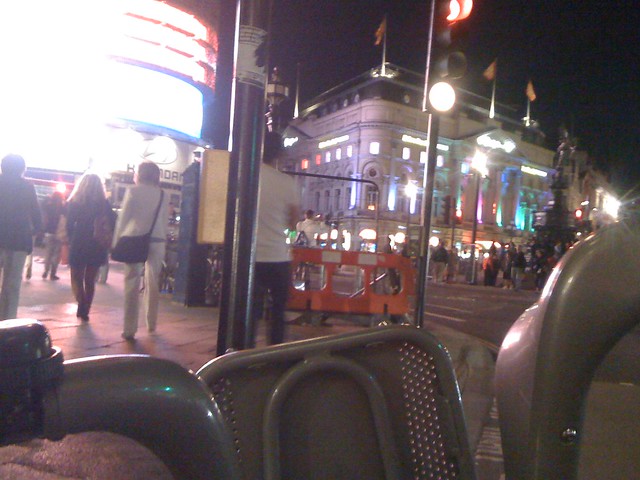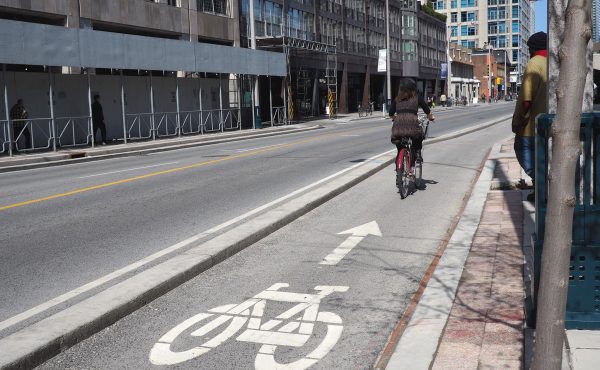
I spent the weekend plus a few days rambling around London. I was there during the first 3 days of the riots, but apart from a Vauxhall house music DJ announcing at 3AM that we should be careful because there was trouble two neighbourhoods away in Brixton, I didn’t see anything myself. Mostly I saw magical London and I saw it euphorically by bicycle — by Boris Bike, more specifically (or Barclay bike, officially, or Bixi, as I couldn’t help calling it). I only rode the Tube twice, once from Heathrow to my hotel in Mayfair, and then out to meet friends in Hackney who gave me their extra bike key. When I was there in November, soon after the bike scheme was introduced, riding about radically changed the way I thought of London (a city I love second only to Toronto) — neighbourhoods suddenly got closer together and there was no more waiting for 4 or 5 AM night busses to take me back to the hotel from wherever I was. The city was liberated and easy.

On this trip, now that some of the euphoria had worn off, I noticed how little I came into conflict with cars. Never, to be precise, and I rode everyday, day and night, on busy high streets and quiet residential streets. The Bixi-style tanks aren’t nimble and light machines like my Specialized hybrid with high pressure tires is back in Toronto; the Boris Bikes lumber along and are a bit slow to start — all things that car drivers don’t like. The lanes are also much narrower, there’s the riding/driving on the left to get used to, and I’m sure there are UK rules of road that I was oblivious to. I was also in mixed traffic mostly. There are a few separated bike lanes (or bike highways) but they were not where I wanted to be (and they aren’t 100% connected) so I rode on regular roads, as everybody else does. There are some on-road bike lanes that appear occasionally — recall the cute narrow ones on Spadina that were removed, but imagine them painted green — but generally I was with the flow of cars, trucks, and busses.

Yet, I was never bothered. The critical difference in the UK is that drivers are skilled. I’ve noticed this also when driving a car on British Motorways or in city centres too. Biking and driving in Toronto are unpleasant not because of bikes, bike infrastructure or even pedestrians: it’s largely because our drivers haven’t ever been taught to properly drive their cars. Toronto and other Ontario cities were mid-western at heart: big, wide and open. When we learned (and still learn) how to drive there wasn’t really a need to get very skilled at it because there was always enough room (for error or otherwise). There was no need to get a real sense of the size of one’s vehicle, how it cornered, or how closely it can pass other objects safely. Now that our cities are crowded, this lack of skill makes driving most unpleasant and unsafe. I noticed this when I took out an Autoshare the day I left to do some errands: over and over, it’s other Toronto drivers that are problem. Mixed with the low skills is an incredible sense of entitlement. On the streets of London I was passed without problem, cars would turn in front of me as I rode but the driver knew his/her speed and size and took the corner with enough room that I didn’t have to break my “spin”. And I didn’t notice much entitlement — drivers waited behind me on the narrow parts patiently, and passed when space opened up.
How this is fixed, I’m not sure. It requires a driving culture change, but when our politicians are more likely to tell drivers what they want to hear — “it’s not you, darling, it’s the <insert anything but cars and drivers> fault” — that’s not likely to change anytime soon.





23 comments
Interesting article. Sadly I doubt this revelation will ever have an effect on our car/bike wars because even more than their sense of entitlement, one thing no driver would ever admit to is the fact that they are a bad driver.
Off topic a bit: sharkskin shoes, black pants and white socks?!
True, telling somebody they’re a bad driver is as verboten as it gets….
Not sharkskin! And silver-grey socks. Yes black pants.
Where can we get a Spacing bag like the one in the top photo?!
“True, telling somebody they’re a bad driver is as verboten as it gets….”
Unless you’re another driver, of course, in which case it’s a daily requirement.
I noticed a similar awareness and acceptance when I cycled through France a few years ago. I remember, quite vividly, finding myself on Champs Elysees or in the roundabout around the Bastille – and realizing that French drivers treated my cycling as they would any other vehicle… I’m sure there are other North American cities where cyclists are treated similarly (Montreal is one…)
anyhoo, nice shoes!
I was in London in June and what I noticed most was that many streets reserved the curb lane for buses, bikes and taxis. Not an ideal situation but a pretty good compromise where there was limited space for bike lanes. The rule is strictly enforced and observed and it works to keep al traffic moving and cyclists tended to take the lane as a result. Other streets have a strict no-stopping rule, which also helps.
I was in London in June and I noticed that streets were the curb lane was reserved for buses, bikes and taxis (a rule that was strictly enforced and observed) had good traffic flow. Cyclists tended to take the lane as a result and generally seems unintimidated. Other streets have strict no-stopping rules during the day, which also helps. I also saw portions of Hyde Park divided into cycling and no-cycling paths and kids being trained to ride there by police.
I think driver education and attitude is a big part of it. Drivers in the UK are happy to use narrow lanes to their fullest, whereas in Canada/US the lanes can never be wide (and somehow safe) enough. Part of it is to accomodate the lowest common denominator – perhaps a new driver or a very old one.
Another improtant reason why UK cycling is more enjopyable has to do with the demographics of cycling. London’s Mayor, Boris Johnson, famously cycles. So do many bankers and lawyers in the City. Because “everyone is a cyclist” in the UK, there’s none of the us-vs-them car-vs-bike rhetoric as is in Toronto.
Partly, I wonder if non-stereotypical cyclists (bankers, conservative politicians, women) were more vocal about their mode of transport could convince more Torontonians that cycling if a valid mode of transport.
Makes sense when you think about how we ‘train’ drivers in Ontario. Memorize the rules of the road for a written test, then a rudimentary driving test and bam, you’re a driver now. No real training behind the wheel unless you decide to take a class, and from what I remember of the one I took (a very long time ago) not much in the way of any serious car handling instruction.
In the meantime I try to bike off the main streets (tough to do, since I work in the downtown core and bike in every day from the burbs) and ride like a) I’m invisible, and b) every driver is a bad driver. Not far from the truth on either count.
Nicely written. With respect to European cities, these are themes that I think most of us already accept as truth but communicating it well is not always easy.
The question which you close is the one we’re all interested in. Politicians are unlikely to lead the way. Don’t waste any more of your life typing that word. They are followers not leaders.
Agree with last post. Can anyone here name a single Bay street lawyer or banker who rides to work? Participation of the elite part of the economic demographic is obviously a big help.
Failing that, I think you can look at critical mass, driven by economic rationale, as being a large part of the answer. Every year, there is a handful more cyclists on the road. Project out by 20-50 years and voila you have something approaching critical mass. At that point, the followers get on board and rewrite the laws. If you get a paradigm shift wherein social factors come into play, things could happen faster. We’ve only just now seen a transition in cage culture wherein ‘small’ is ‘cool’. For years Detroit motors claimed they couldn’t build or sell a small car. Now, it seems they can and the results are reflected in the designs. They look good. They have alloy wheels. They’re small but not cheap. Personally I’m expecting ebikemotoscooters to hit the ‘cool’ jackpot and go mainstream before bicycles, but who knows.
You’d fail a driving test in Germany if you didn’t do a shoulder check for cyclists when making a right turn (cyclists have the right of way on separated bike lanes that run beside the road)! I failed my driver’s test in Ontario for hitting the curb when parallel parking, so I think such a requirement to do a shoulder check could be easily incorporated.
Yes, I can name some “elite” bay st lawyer etc folks who do bike.
The aim for the final drivers road test, seems to be that 95% will pass the first time. Personally I think the final test should be on a simulator, that throws about 25 different scenarios at you, The idea being that if you hit something, you fail and need to wait 14 days before trying again. While we are at it, you should need to pass the same test, every drivers licence renewal. If you as a licensed driver fail, you can not get your renewal until you do pass.
Linked and made the ‘Quote of the day’ on my blog. This is also why I enjoy cycling in much heavier traffic in Tokyo than in any traffic in Toronto. Here it has a lot to do with something called enforcement. You know, other than the laziness of only parking and speed enforcement in N. America.
http://hanlonsrzr.blogspot.com/2011/08/quote-of-day-another-reason-toronto.html
There is a major difference in how hard the driving test is in the UK and Canada. When I took my test (1990) in the UK it was accepted that it was challenging and roughly half the people failed the first time round. If you fail then you had to wait a few months to re-take. It was not uncommon to fail more than once. I don’t know if this has changed since, but I think it accounts for why UK drivers are better.
As a Brit living in Toronto, I agree with the article – Toronto should be fine for cycling – the roads are much wider and less crowded than London. At the end of the day, there is plenty of room for bikes. However, the drivers here are absolutely nuts. I don’t drive much, but every time I get on the highway I see something crazy (drivers changing 4 lanes simultaneously without signalling etc.).
To me, there are two solutions (i) the cops have to enforce the rules of the road and give out more tickets for dangerous driving (ii) the driving test needs to be made more challenging.
There is also the fact that money was spent on campaigns to increase awareness of cyclists.
http://www.youtube.com/watch?v=f_9INBPUX9U
I can’t imagine this kind of money being spent by the City of Toronto.
I’m tempted to agree with the general point that Toronto’s drivers aren’t very skilled. But I wonder if has to do with learning to drive on Ontario’s big, wide roads. How many people with Ontario Driver’s Licences learned to drive in Ontario, or even Canada? I think, as others have pointed out, it’s far too easy to get a Licence here. I just read that in other bicycle-friendly cities a Licence costs about $1000. That Ontario has implemented ‘Graduated Licensing’ seems to show that more training is needed, but that it’s still ok (perhaps necessary) that people be allowed to drive before they’re fully trained – and the restrictions are about alcohol, passengers and staying of the 400 series highways (busy cities are ok!):
http://www.mto.gov.on.ca/english/dandv/driver/gradu/
Growing up in Ontario, I remember getting a Licence was a kind of ‘rite of passage’ and, because of the lack of public transportation, getting a Licence was a near necessity to some form of ‘adult freedom.’ It’s unfortunate, but having a Driver’s Licence is pretty much a ‘right’ not a ‘privilege.’
Consider also that many of the cars here in Toronto may be much larger than the cars in London. No F-150s over there.
Strangely enough, despite knowing London quite well, the one thing I’ve always been afraid to do was cycle. I think I’ll change that on my next trip!
I don’t doubt Europe’s has better driver training standards but as you hinted at, London is also a medieval city with relatively small and windy mixed-use streets that were never made “grande” a la Paris (except in a few points like Regent Street). Therefore, one’s attention to the road as they drive a vehicle is both a necessity and a habit. There’s just so many things to look-out for (i.e., bus lanes, pedestrian crossings, Barclay’s bikes, roundabouts, parked delivery trucks, taxis ranks, etc.) Most in North America, even if they live an urban life now, were brought up in the suburbs, where as Shawn says “there was always enough room,” and were taught more about proper turning, proper speeds, not running a yellow, etc. However, very little education about simply “being aware” of everything going on around you (including streetcar doors as an obvious example). I think this also ties-into the whole woonerf movement that creates safer streets for everyone by removing all the signage clutter and simply forcing everyone to be more aware.
It’s probably also worth mentioning that the “us” vs “them” mentatlity about cycling/driving in Toronto should be disproved with a proper study. In Washington, DC it was recently found that those that cycle in the DC-area actually have the highest incomes (even more so than most drivers)!
Maybe not to the extent that they do in London, but I think many bankers, lawyers, etc. likely bike in T.O. too (if fact I see many on my commute). It’s just that we allow old conceptions about who bikes to dominate the discourse and an ill-informed ignoramous of a mayor to play on them.
I used to cycle a lot in London in the late 80’s and early 90’s, and it was just as unpleasant and dangerous as cycling in Toronto is these days. Cars would cut me up or pass too close, just like they do in Toronto. My accident rate was similar (I’ve had one serious accident in each city).
So, perhaps things have changed in London over the last 20 years. British/European cars have got smaller? Congestion pricing keeps more people off the roads? Cycling awareness campaigns have worked?
Another interesting difference: there are almost no motorbikes in Toronto, whereas there always were plenty in London. Does more variety of traffic on the roads lead to better accommodation of cyclists?
Just to confirm the point earlier that British drivers actually are more skilled – the driver’s test is famously difficult, and as a result the training is very intensive.
Also, in much of Britain you really don’t need to drive if you don’t want to. Trains, buses and taxis will get you most places you need to go affordably. Maybe that keeps some of the marginal drivers off the road. Whereas in Ontario, unless you live in downtown Toronto, having access to a car is pretty necessary for everyday life, so even if people aren’t great drivers they still need to do it (which is one of the reasons it would be difficult to make the test more challenging here).
Shaun is absolutely correct that Toronto drivers need cyclist sensitivity training. Fortunately, the Ontario Medical Association (OMA) agrees. In response to the 22,000 cyclists who visited emergency departments across Ontario, they recently recommended a number of measures that address this very point. They suggest that provincial driver training manuals and driver exams both include sections on how to share the road with cyclists. Let’s support the OMA on this helpful initiative!
Another factor to consider is that Ontario spends no money on cycling infrastructure, nor any on cycling infrastructure. As the Green Party’s transport critic, I’m calling for 1% of the Ontario Ministry of Transportation’s $5.8 billion budget to be dedicated to each of these critical aspects of sustainable transportation. Having the province provide such funding will ensure that walking and cycling are taken more seriously in transportation planning in cities and towns across Ontario.
Tim Grant, Green Party of Ontario, Trinity-Spadina candidate
http://www.VoteTimGrant.ca